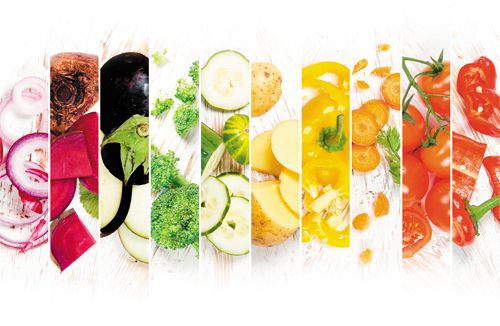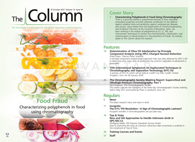Characterizing Polyphenols in Food Using Chromatography
There is a growing interest in polyphenols because of their noticeable antioxidant properties and their potential contribution to the defence against oxidative stress and protection against cardiovascular diseases and cancers. Oscar Núñez from the Department of Chemical Engineering and Analytical Chemistry at the University of Barcelona in Barcelona, Spain, has been working since 2010 in the analysis of polyphenols by capillary electrophoresis (CE), liquid chromatography (LC), mass spectrometry (MS), and chemometric techniques to achieve the characterization, classification, and authentication of natural products in the prevention of frauds. He recently spoke to The Column about this research.
Photo Credit: Linda Vostrovska/Shutterstock.com

There is a growing interest in polyphenols because of their noticeable antioxidant properties and their potential contribution to the defence against oxidative stress and protection against cardiovascular diseases and cancers. Oscar Núñez from the Department of Chemical Engineering and Analytical Chemistry at the University of Barcelona in Barcelona, Spain, has been working since 2010 in the analysis of polyphenols by capillary electrophoresis (CE), liquid chromatography (LC), mass spectrometry (MS), and chemometric techniques to achieve the characterization, classification, and authentication of natural products in the prevention of frauds. He recently spoke to The Column about this research. - Interview by Kate Mosford
Q. Why are polyphenols an important area in food analysis?
A: Polyphenols are aromatic secondary metabolites ubiquitously spread through the plant kingdom and comprising more than 8000 substances with high diversity in structure and bioactive activities. They are widely distributed in the human diet, particularly in fruits, vegetables, and beverages. Today, researchers, food manufacturers, and the public in general are very interested in the quality of food products, not only from the point of view of essential nutrients and bioactive compounds, but also for the presence of undesired contaminants. Although consumer preferences regarding food products are mainly influenced by organoleptic (colour, taste, aroma) and socioeconomic (ecological production, guaranteed origin, and quality) factors, people are increasingly more interested in, and even demanding, the presence of some specific compounds with beneficial health properties, which has given rise to the production of functionalized food products. The main reason for the great interest in polyphenols is from recognition of their antioxidant properties, but also for their probable role in the prevention of various diseases because many of them present antimutagenic and antitumour bioactivities, as well as anti-obesity effects (1). The determination and characterization of polyphenols in food is therefore becoming one of the most important research areas in food analysis.
Q. What difficulties do polyphenols present for the analyst?
A: There are two main difficulties related to the determination of polyphenols in food products. The first one is, in fact, the food matrices, and is a common issue in the analysis of foodstuffs. Food products are very complex mixtures consisting of naturally occurring compounds (lipids, carbohydrates, proteins, vitamins, organic acids, volatile organic compounds) as well as many other substances arising from technological processes, agrochemical treatments, or migrating from packaging materials. So, when we are dealing with the analysis of food products, the variability of food matrices and the presence of possible interferences are unknown. The second difficulty is related to the high structure diversity of polyphenols, from very small molecules such as phenolic acids (with molecular masses lower than 100 Da) to big molecules (>30,000 Da) for highly polymerized compounds. Strictly speaking, polyphenols should contain various aromatic rings with one or several hydroxyl (−OH) groups. However, other compounds such as some phenolic acids (some benzoic and cinnamic acids), which do not match with these structure requirements, are also often considered in an extended version of polyphenolic matter. According to the number of aromatic phenol rings that they contain as well as the structural elements that bind these rings together, polyphenols are typically classified into four main groups: (i) phenolic acids, (ii) flavonoids, (iii) lignans, and (iv) stilbenes (2). Moreover, other organic functional groups can also be present in their structures, and the possibility of isomeric compounds is huge.
So, when you combine both the great number and structure variability of polyphenols with the complexity of food matrices, the analysis of polyphenols in food products becomes a very challenging but also very interesting topic for analysts.
Q. Liquid chromatography coupled to mass spectrometry (LC–MS) and LC coupled to high-resolution (HR) MS are now commonly used to analyze polyphenols. What are the latest advances in these analytical techniques in relation to polyphenols?
A: The goal of analytical researchers today is attempting to determine many analytes in complex mixtures such as food in the quickest analysis time possible. For this reason, liquid chromatography coupled to mass spectrometry (LC–MS) or tandem mass spectrometry (LC–MS/MS) are the most widely used techniques for the determination of polyphenols in food products. The latest advances related to these techniques in this field are based on the use of fast chromatography separations by developing ultrahigh-pressure liquid chromatography (UHPLC) methods either using sub-2-µm particle packed columns or porous shell columns (with sub-3-µm superficially porous particles) (3–5). LC separation of polyphenols is mainly addressed by C18 or C8 reversed-phase chromatography, although lately the use of other chromatographic separation modes such as hydrophilic interaction chromatography (HILIC) with amide-bonded stationary phases has also been described (6). Pentafluorophenyl (PFP) columns have also proven to be very useful in the separation and determination of polyphenols, offering superior resolving power than C18 columns when dealing with complex anthocyanin-based matrices, such as those found in hybrid grape cultivars (7).
Liquid chromatography coupled to high resolution mass spectrometry (LC–HRMS) has become the most powerful technique for the determination of polyphenols in food. When dealing with complex matrices such as food products, an adequate mass resolution becomes essential. Consequently, HRMS has gained wide acceptance as a highly sensitive and selective technique for the determination of polyphenols in food matrices by virtue of its numerous and significant advantages over low resolution mass spectrometry. The high resolution and high accuracy on the mass measurements achieved by HRMS enhances the possibility of unambiguously determining the elemental composition of known and new constituents with a high level of accuracy, typically below 5 ppm, which allows the analyst to also distinguish between target analytes and other coeluting isobaric compounds. This is very important when targeting polyphenols because of their high structure diversity and the complexity of food matrices. Time-of-flight (TOF) instruments were once the most commonly employed, but the panorama has now changed and Orbitrap analyzers have become the mainstream HRMS instruments for the analysis of food polyphenols (5). Among them, hybrid mass spectrometers, which are devices resulting from the combination of two or more analyzers of different types, are undoubtedly today’s method of choice for modern analytical chemists because they combine the different performance characteristics (that is, mass resolving power, speed of analysis, and dynamic range of mass accuracy) offered by the various types of analyzers in one mass spectrometer (8). Among them, hybrid mass spectrometers using linear ion trap technology have evolved into the most common mass spectrometers used in the polyphenolic field. In fact, these hybrid mass spectrometers offer the possibility of screening and achieving the identification and structural characterization of unknown polyphenolic compounds by using, for example, exact mass to calculate the most favourable elemental composition and the accurate mass of the MSn product ions in the data dependent scan (9).
Q. Have there been any developments in sample preparation for the analysis of polyphenols?
A: If we want to cope with the requirements of high-throughput separations with cost-effective methodologies and reduced analysis time, the use of ultrafast separations will not be enough to develop a fast analytical method in food analysis. Moreover, the ability to analyze multiple compounds for both target and nontarget screening, minimizing sample preparation, is needed. When considering polyphenols, we deal with more than 8000 compounds with different structures and physicochemical properties, so a specific sample extraction and preparation method will work for some polyphenols but not for others. Sample extraction and treatment must therefore also be optimized in combination with the fast separations when considering a reduction in the total analysis time. Currently, the developments in sample preparation for the analysis of polyphenols are moving towards generic sample extraction procedures and a reduction of sample preparation and cleanup steps. This is possible today, even when you are aware that the number of interfering compounds will increase when reducing sample preparation steps, thanks to the great advancements in analytical techniques such as HRMS and in data treatment approaches based on chemometrics.
The latest trends in sample preparation methods for the analysis of polyphenols use liquid–liquid extraction (LLE) methods with direct injection of the extracts (without any cleanup steps), and the use of solid-phase extraction (SPE), which offers the advantage of being rapid, economical, simple to use, and provides cleaner extracts. One approach I have found very interesting in this field is the employment of QuEChERS (Quick, Easy, Cheap, Effective, Rugged, and Safe) procedures. QuEChERS entails solvent extraction with acetonitrile, ethyl acetate, or other organic solvents, and partitioning with magnesium sulphate, alone or with other salts, generally sodium chloride, followed by a cleanup step using dispersive solid-phase extraction (dSPE) adding small amounts of bulk SPE sorbents (C18, graphitized carbon, primary secondary amine [PSA]) to the extract. Although initially developed for the analysis of pesticides, this sample preparation technique is becoming very popular for the analysis of other compounds in food. The use of QuEChERS for the sensitive quantification of multiclass polyphenols in, for instance, wines has been proven (10).
Q. Do you have any comments on the practical use of chemometrics for polyphenol research and the practical use of chemometrics for chromatographers in general?
A: Chemometrics can extract information from chemical systems by data-driven means. Regarding polyphenols, apart from the sensory and functional properties attributed to these compounds, their impact on the characterization, classification, and even authentication studies of natural products cannot be underestimated. Polyphenols and phenolic acid contents appear to be related to several food features such as the climate conditions, the water resources, the cultivar growing geographical areas and cultivation techniques, the soil management, and the degree of maturation of fruits and vegetables. As a result, polyphenolic distribution and content can be exploited as a source of analytical data to establish natural product classifications and to guarantee product designation of origin (PDO) (11,12), or to achieve product authentication and to prevent food adulterations (13). Moreover, the total amount of data extracted by modern analytical techniques available today, such as HRMS, requires the use of appropriate chemometric methods to extract the underlying chemical information. Thus, chemometrics has become an indispensable tool when dealing with the analysis of polyphenols in food (14).
For analysts, chemometrics is becoming a powerful, and in some cases indispensable, technique. Chemometrics are heavily used in analytical chemistry in metabolomics, proteomics, and foodomics, and the development of improved chemometric methods of analysis also continues to advance the state of the art in analytical instrumentation and methodology. In fact, it is a life discipline, and many academic groups are dedicated to the continued development of chemometric theory and methods. Chemometrics is particularly useful for chromatographers when dealing with a comprehensive optimization of sample extraction and chromatographic conditions. Often, optimization is conducted by trialâandâerror in which the study is performed without a pre-established plan of experiments. Although quite popular, this strategy is usually inefficient and time-consuming. In this regard, the chemometric design of experiments (DOE) has proven to be highly effective in establishing the best sample treatment and chromatographic conditions from a reduced set of experiments (15).
Q. What other areas of food analysis does your group focus on?
A: My research group also focuses on food safety issues. We focus on the development of analytical methodologies based on liquid chromatography and gas chromatography coupled to mass spectrometry techniques for the determination of multiple food contaminants (pesticides, perfluorinated compounds). One of the most interesting research lines, which I have been involved in for several years, is the analysis of food packaging contaminants (16). If you ask educated consumers about the principal source of food contamination they will list pesticides as the first item, then environmental chemicals (PCBs and veterinary drugs, among others). Few would even mention food packaging materials, although the amount of material migrating from food packaging into food may well be 100 times greater than the contribution of pesticides or environmental pollutants. Moreover, it is difficult to compare the toxicity (primarily acute) of well-controlled pesticides with the potential (primarily chronic) toxicity of frequently unidentified compounds entering food from packaging materials. We are currently working on developing analytical methodologies for the determination of food packaging phthalates, which is a difficult task because these compounds are ubiquitously spread in the laboratory environment, making this work both interesting and challenging at the
same time.
References
- A. Scalbert, C. Manach, C. Morand, C. Remesy, and L. Jiménez, Crit. Rev. Food Sci. Nutr. 45, 287–306 (2005).
- C. Manach, A. Scalbert, C. Morand, C. Remesy, and L. Jiménez, Am. J. Clin. Nutr. 79, 727–747 (2004).
- O. Núñez, H. Gallart-Ayala, C.P.B. Martins, and P. Lucci, J. Chromatogr. A 1228, 298–323 (2012).
- O. Núñez, H. Gallart-Ayala, C.P.B. Martins, and P. Lucci, Eds., Fast Liquid Chromatography-Mass Spectrometry Methods in Food and Environmental Analysis (Imperial College Press, London, UK, 2015).
- P. Lucci, J. Saurina, and O. Núñez, Trends in Anal. Chem. 88, 1–24 (2017).
- A.J. Steevensz, S.L. Mackinnon, R. Hankinson, C. Craft, S. Connan, D.B. Stengel, and J.E. Melanson, Phytochem. Anal. 23, 547–553 (2012).
- D.C. Manns and A.K. Mansfield, J. Chromatogr. A 151, 111–121 (2012).
- P. Lucci and C.P.B. Martins, in Fast Liquid Chromatography-Mass Spectrometry Methods in Food and Environmental Analysis, O. Núñez, H. Gallart-Ayala, C.P.B. Martins, and P. Lucci, Eds. (Imperial College Press, London, UK, 2015), pp. 325–345.
- S. Keckes, U. Gasic, T.C. Velickovic, D. Milojkovic-Opsenica, M. Natic, and Z. Tesic, Food Chem. 138, 32–40 (2013).
- A.R. Fontana and R. Bottini, J. Chromatogr. A 1342, 44–53 (2014).
- H. Franquet-Griell, A. Checa, O. Núñez, J. Saurina, S. Hernández-Cassou, and L. Puignou, J. Agric. Food Chem. 60, 8340–8349 (2012).
- M. Farrés-Cebrián, R. Seró, J. Saurina, and O. Núñez, Separations 3, 33 (2016).
- N. Pardo-Mates, A. Vera, S. Barbosa, M. Hidalgo-Serrano, O. Núñez, J. Saurina, S. Hernández-Cassou, and L. Puignou, Food Chem. 221, 29–38 (2017).
- M. Hidalgo-Serrano, J. Saurina, and O. Núñez, in Chemometrics: Methods, Applications and New Research, A.S. Luna, Ed. (Nova Science Publishers Inc., New York, USA, 2017), pp. 109–136.
- L. Eriksson, E. Johansson, N. KettanehâWold, C. Wikström, and S. Wold, Design of Experiments. Principles and Application 3rd edition (Umetrics Academy, Umea, Sweden, 2008).
- H. Gallart-Ayala, O. Núñez, and P. Lucci, Trends in Anal. Chem. 42, 99–124 (2013).

Oscar Núñez studied chemistry at the University of Barcelona where he also received his Ph.D. in 2004. He worked as a visiting researcher for half a year in the development of on-line preconcentration methods using micellar electrokinetic chromatography (MEKC) at the University of Hyogo (Japan) in collaboration with Professor Terabe (father of the MEKC technique). In October 2005, he joined the Kyoto Institute of Technology (Japan) as a two-year postdoc researcher working with Professor Tanaka developing monolithic silica capillary columns under a fellowship from the Japan Society for the Promotion of Science. In November 2007, he joined the University of Barcelona again, working in the chromatography, capillary electrophoresis, and mass spectrometry research group. Since December 2014, he has been a Serra Húnter Professor at the Department of Chemical Engineering and Analytical Chemistry, and a member of the Research Institute in Food Nutrition and Food Safety of the University of Barcelona. He has more than 90 scientific papers and book chapters to his name, and he is editor of two books: Fast Liquid Chromatography–Mass Spectrometry Methods in Food and Environmental Analysis by Imperial College Press (2015), and New Trends in Sample Preparation Techniques for Food Analysis by Nova Science Publishers (2016). He has extensive experience in the development of capillary electrophoresis and liquid chromatography methods coupled to tandem mass spectrometry and high resolution mass spectrometry, as well as sample treatment procedures for environmental and food analysis. Since 2010, his major research areas have involved the analysis of polyphenols to achieve the characterization, classification, and authentication of natural products in the prevention of frauds.
E-mail: oscar.nunez@ub.eduWebsite:www.ub.edu/dqa/eng/index_eng.html

Analytical Challenges in Measuring Migration from Food Contact Materials
November 2nd 2015Food contact materials contain low molecular weight additives and processing aids which can migrate into foods leading to trace levels of contamination. Food safety is ensured through regulations, comprising compositional controls and migration limits, which present a significant analytical challenge to the food industry to ensure compliance and demonstrate due diligence. Of the various analytical approaches, LC-MS/MS has proved to be an essential tool in monitoring migration of target compounds into foods, and more sophisticated approaches such as LC-high resolution MS (Orbitrap) are being increasingly used for untargeted analysis to monitor non-intentionally added substances. This podcast will provide an overview to this area, illustrated with various applications showing current approaches being employed.













